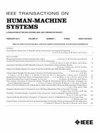机器人辅助手部痉挛评估综述
IF 3.5
3区 计算机科学
Q2 COMPUTER SCIENCE, ARTIFICIAL INTELLIGENCE
引用次数: 0
摘要
痉挛是上运动神经元病变后常见的神经肌肉异常。传统的痉挛评估方法是通过人工临床量表进行评估,但由于存在主观性,这种方法存在局限性。康复机器人技术的发展为这一问题带来了新的解决方案,产生了新颖的机器人辅助痉挛评估方法。本文在回顾2000年1月至2023年2月期间用于上肢痉挛评估的仪器临床量表、生物力学和神经生理学测量方法以及医学成像方法的基础上,介绍了机器人辅助手部痉挛评估(RAHSA)的现状和挑战。手部解剖和痉挛症状的特点使得开发 RAHSA 方法和相应的机器人系统具有挑战性。虽然手部机器人和仪器评估方法的结合已经引起了对RAHSA的研究,但对于融合神经学和非神经学测量方法的新评估方法以及专为手部痉挛评估设计的新型机器人系统,还需要进行更多的研究。本文章由计算机程序翻译,如有差异,请以英文原文为准。
A Review of Robot-Assisted Hand Spasticity Assessment
Spasticity is a common neuromuscular abnormality following upper motor neuron lesions. Conventionally, spasticity is assessed through manual clinical scales, which have limitations due to the subjectivity involved. The development of rehabilitation robotics introduced new solutions to this problem, producing novel robot-assisted spasticity assessment approaches. In this article, we present the current state and challenges of robot-assisted hand spasticity assessment (RAHSA) based on a review of instrumented clinical scales, biomechanical and neurophysiological measures, and medical imaging methods for upper extremity spasticity assessment between January 2000 and February 2023. The characteristics of hand anatomy and spasticity symptoms make it challenging to develop RAHSA approaches and corresponding robotic systems. Although the combination of hand robots and instrumented assessment methods has evoked studies on RAHSA, more research is needed on the new assessment approaches fusing neurological and nonneurological measures and novel robotic systems specifically designed for hand spasticity assessment.
求助全文
通过发布文献求助,成功后即可免费获取论文全文。
去求助
来源期刊

IEEE Transactions on Human-Machine Systems
COMPUTER SCIENCE, ARTIFICIAL INTELLIGENCE-COMPUTER SCIENCE, CYBERNETICS
CiteScore
7.10
自引率
11.10%
发文量
136
期刊介绍:
The scope of the IEEE Transactions on Human-Machine Systems includes the fields of human machine systems. It covers human systems and human organizational interactions including cognitive ergonomics, system test and evaluation, and human information processing concerns in systems and organizations.
 求助内容:
求助内容: 应助结果提醒方式:
应助结果提醒方式:


